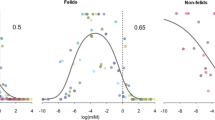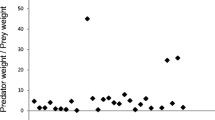Abstract
The ability to determine the prey-specific biomass intake of large predators is fundamental to their conservation. In the absence of actual prey data, researchers generally use a “unit mass” method (estimated as 3/4 adult female mass) to calculate the biomass intake of predators. However, differences in prey preference and range across geographic regions are likely to have an influence on biomass calculations. Here we investigate the influence of estimated prey mass on leopard biomass calculations, and subsequent carrying capacity estimates, in an understudied mountain population. Potential leopard feeding sites were identified using global positioning system (GPS) location clusters obtained from GPS collars. We investigated 200 potential leopard feeding sites, of which 96 were actual feeding sites. Jaw bones, horns, hooves, and other indicative bones were used to determine gender and age of prey items, which were subsequently used to calculate mass of each prey item based on previously published values. There were significant differences in the biomass values calculated using the traditional unit mass method and the calculated prey masses obtained from leopard feeding sites. However, there were no considerable differences in the carrying capacity estimates using the preferred prey species model and leopard density estimates calculated using a non-biased spatial approach, which suggests that estimating carnivore carrying capacity based on 3/4 adult female masses is a reliable method also for the mountain population in this study.
Similar content being viewed by others
References
Bisset C, Bernard RTF, Parker DM (2012) The response of lions (Panthera leo) to changes in prey abundance on an enclosed reserve in South Africa. Acta Theriol 57:225–231
Buys D, Keogh HJ (1984) Notes on the microstructure of hair of the Orycteropodidae, Elephantidae, Equidae, Suidae and Giraffidae. S Afr J Wild Res 14:111–119
Child G (1964) Growth and ageing criteria of impala, Aepyceros melampus. Arnoldia 27:128–135
De Klerk A (2003) Waterberg biosphere: a land use model for ecotourism development. MSc Thesis, University of Pretoria.
Dreyer JH (1966) A study of the hair morphology in the family Bovidae. Onderstepoort J Vet Res 379–472
Efford M (2004) Density estimation in live-trapping studies. Oikos 106:598–610
Efford MG (2012) secr: Spatially explicit capture–recapture models. R package version 2.3.2. http://CRAN.R-project.org/package=secr. Accessed 1 Aug 2012
Efford MG, Borchers DL, Byrom AE (2009) Density estimation by spatially explicit capture–recapture: likelihood-based methods. In: Thompson DL, Cooch EG, Conroy MJ (eds) Modeling demographic processes in marked populations. Springer, New York, pp 255–269
Estes JA, Terborgh J, Brashares JS, Power ME, Berger J, Bond WJ, Carpenter SR, Essington TE, Holt RD, Jackson JBC, Marquis RJ, Oksanen L, Oksanen T, Paine RT, Pikitch EK, Ripple WJ, Sandin SA, Scheffer M, Schoener TW, Shurin JB, Sinclair ARE, Soulé ME, Virtanen R, Wardle DA (2011) Trophic downgrading of planet Earth. Science 333:301–306
Frank L, Simpson D, Woodroffe R (2003) Foot snares: an effective method for capturing African lions. Wildl Soc Bull 31:309–314
Fuller TK, Sievert PR (2001) Carnivore demography and the consequences of changes in prey availability. In: Gittleman JL, Funk SM, MacDonald DW, Wayne RK (eds) Carnivore conservation. Cambridge University Press and the Zoological Society of London, Cambridge
Gerber B, Karpanty S, Kelly MJ (2012) Evaluating the potential biases in carnivore capture–recapture studies associated with the use of lure and varying density estimation techniques using photographic-sampling data of the Malagasy civet. Popul Ecol 54:43–54
Gray TNE, Prum S (2012) Leopard density in post-conflict landscape, Cambodia: evidence from spatially explicit capture–recapture. J Wildl Manag 76:163–169
Grimbeek AM (1992) The ecology of the leopard (Panthera pardus) in the Waterberg. MSc Thesis, University of Pretoria
Gusset M, Burgener N (2005) Estimating larger carnivore numbers from track counts and measurements. Afr J Ecol 43:320–324
Hayward MW (2006) Prey preferences of the spotted hyaena (Crocuta crocuta) and degree of dietary overlap with the lion (Panthera leo). J Zool (London) 270:606–614
Hayward MW, Kerley GIH (2005) Prey preferences of the lion (Panthera leo). J Zool (London) 267:309–322
Hayward MW, Henschel P, O'Brien J, Hofmeyr M, Balme G, Kerley GIH (2006) Prey preferences of the leopard (Panthera pardus). J Zool (London) 270:298–313
Hayward MW, Adendorff J, Moolman LC, Hayward GJ, Kerley GIH (2007a) The successful reintroduction of leopard Panthera pardus to the Addo Elephant National Park. Afr J Ecol 45:103–104
Hayward MW, O’Brien J, Kerley GIH (2007b) Carrying capacity of large African predators: predictions and tests. Biol Conserv 139:219–229
Jooste E, Pitman RT, Van Hoven W, Swanepoel LH (2012) Unusually high predation on Chacma baboons by female leopards in the Waterberg Mountains, South Africa. Folia Primatol 83:353–360
Karanth KU, Nichols JD (1998) Estimation of tiger densities in India using photographic captures and recaptures. Ecology 79:2852–2862
Karanth KU, Nichols JD (eds) (2002) Monitoring tigers and their prey: a manual for researchers, managers and conservationists in Tropical Asia. Centre for Wildlife Studies, Bangalore
Karanth KU, Chundawat RS, Nichols JD, Kumar NS (2004) Estimation of tiger densities in the tropical dry forests of Panna, Central India, using photographic capture–recapture sampling. Anim Conserv 7:285–290
Keogh HJ (1979) An atlas of hair from southern African mammal species with reference to its taxonomic and ecological significance. Dissertation, University of Pretoria
Keogh HJ (1983) A photographic reference system of the microstructure of the hair of southern African bovids. S Afr J Wildl Res 13:89–132
Kilian PJ (2003) The ecology of reintroduced lions on the Welgevonden Private Game Reserve, Waterberg. Thesis, University of Pretoria
Martins Q, Horsnell WGC, Titus W, Rautenbach T, Harris S (2011) Diet determination of the Cape Mountain leopards using global positioning system location clusters and SCAT analysis. J Zool (London) 283:81–87
Norton PM, Fairall N (1991) Mountain reedbuck Redunca fulvorufula growth and age determination using dentition. J Zool (London) 225:293–307
Noss AJ, Gardner B, Maffei L, Cuéllar E, Montaño R, Romero-Muñoz A, Sollman R, O'Connell AF (2012) Comparison of density estimation methods for mammal populations with camera traps in the Kaa-lya del Gran Chaco landscape. Anim Conserv 15(5):527–535
Obbard ME, Howe EJ, Kyle CJ (2010) Empirical comparison of density estimators for large carnivores. J Appl Ecol 47:76–84
Owen-Smith N, Mills MGL (2008) Predator–prey size relationships in an African large-mammal food web. J Anim Ecol 77:173–183
Pitman RT, Swanepoel LH, Ramsay PM (2012) Predictive modelling of leopard predation using contextual Global Positioning System cluster analysis. J Zool (London) 288:222–230
Radloff FGT, Du Toit JT (2004) Large predators and their prey in a southern African savanna: a predator's size determines its prey size range. J Anim Ecol 73:410–423
Rexstadt E, Burnham K (1991) User's guide for interactive program CAPTURE. Colorado Cooperative Fish and Wildlife Research Unit. Colorado State University, Fort Collins
Roettcher D, Hofmann RR (1970) The ageing of impala from a population in the Kenya rift valley. East Afr Wildl J 8:37–42
Schaller GB (1972) The Serengeti lion. University of Chicago Press, Chicago
Seydack AHW (1983) Age assessment of the bushpig Potamochoerus porcus Linn. 1758 in the Southern Cape. Thesis, University of Pretoria
Simpson CD (1966) Tooth eruption, growth and ageing criteria in greater kudu—Tragelaphus strepsiceros Pallas. Arnoldia 2:1–12
Skinner JD, Chimimba CT (Rev) (2005) The mammals of the southern African subregion, 3rd edn. Cambridge University Press, Cambridge
Smuts GL (1972) Seasonal movements, migration and age determination of Burchell's zebra (Equus burchelli antiquorum, H. Smith, 1841) in the Kruger National Park. Thesis, University of Pretoria
Smuts GL (1974) Growth, reproduction and population characteristics of Burchell's zebra (Equus burchelli antiquorum, H. Smith, 1841) in the Kruger National Park. Dissertation, University of Pretoria
Soisolo MK, Cavalcanti SMC (2006) Estimating the density of a jaguar population in the Brazilian Pantanal using camera-traps and capture–recapture sampling in combination with GPS radio-telemetry. Biol Conserv 129:487–496
Stoltz LP (1977) The population dynamics of baboons Papio ursinus Kerr 1792, in the Transvaal. Dissertation, University of Pretoria
Strauss RE (1979) Reliability estimates for Ivlev's electivity Index, the forage ratio, and a proposed linear index of food selection. T AM Fish Soc 108:344–352
Tambling CJ, Cameron EZ, Du Toit JT, Getz WM (2010) Methods for locating African lion kills using global position system movement data. J Wildl Manage 74:549–56
Valeix M, Chamaille´-Jammes S, Loveridge AJ, Davidson Z, Hunt JE, Madzikanda H, Macdonald DW (2011) Understanding patch departure rules for large carnivores: lion movements support a patch-disturbance hypothesis. Am Nat 178:269–275
Van Orsdol KG, Hanby JP, Bygott JD (1985) Ecological correlates of lion social organisation (Panthera leo). J Zool (London) 206:97–112
Wang SW, Macdonald DW (2009) The use of camera traps for estimating tiger and leopard populations in the high altitude mountains of Bhutan. Biol Conserv 142:606–613
Wilson VJ (1965) Observations on the greater kudu Tragelaphus strepsiceros Pallas from a tsetse control hunting scheme in Northern Rhodesia. East Afr Wildl J 3:27–37
Wilson VJ, Child G (1965) Notes on klipspringer from tsetse fly control areas in Eastern Zambia. Arnoldia 1:1–19
Wilson VJ, Schmidt JL, Hanks J (1984) Age determination and body growth of the common duiker Sylvicapra grimmia (Mammalia). J Zool (London) 202:283–297
Acknowledgments
We thank the management team of Welgevonden Private Game Reserve for assistance during fieldwork and Justin Boyles for valuable input into this paper. Funding was received from the Wilson Foundation and Centre for Wildlife Management, University of Pretoria. Darien Simpson and Anton van Loggerenberg assisted with the capturing of leopards. LHS was supported by National Research Foundation grant number 74819. We also thank two anonymous reviewers for the improvement of this paper.
Author information
Authors and Affiliations
Corresponding author
Additional information
Communicated by C. Gortazar
Rights and permissions
About this article
Cite this article
Jooste, E., Hayward, M.W., Pitman, R.T. et al. Effect of prey mass and selection on predator carrying capacity estimates. Eur J Wildl Res 59, 487–494 (2013). https://doi.org/10.1007/s10344-013-0696-9
Received:
Revised:
Accepted:
Published:
Issue Date:
DOI: https://doi.org/10.1007/s10344-013-0696-9




